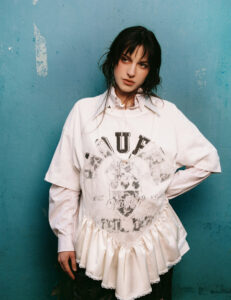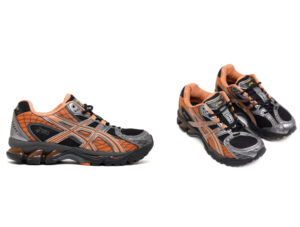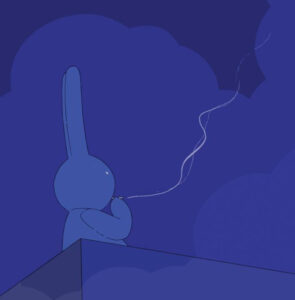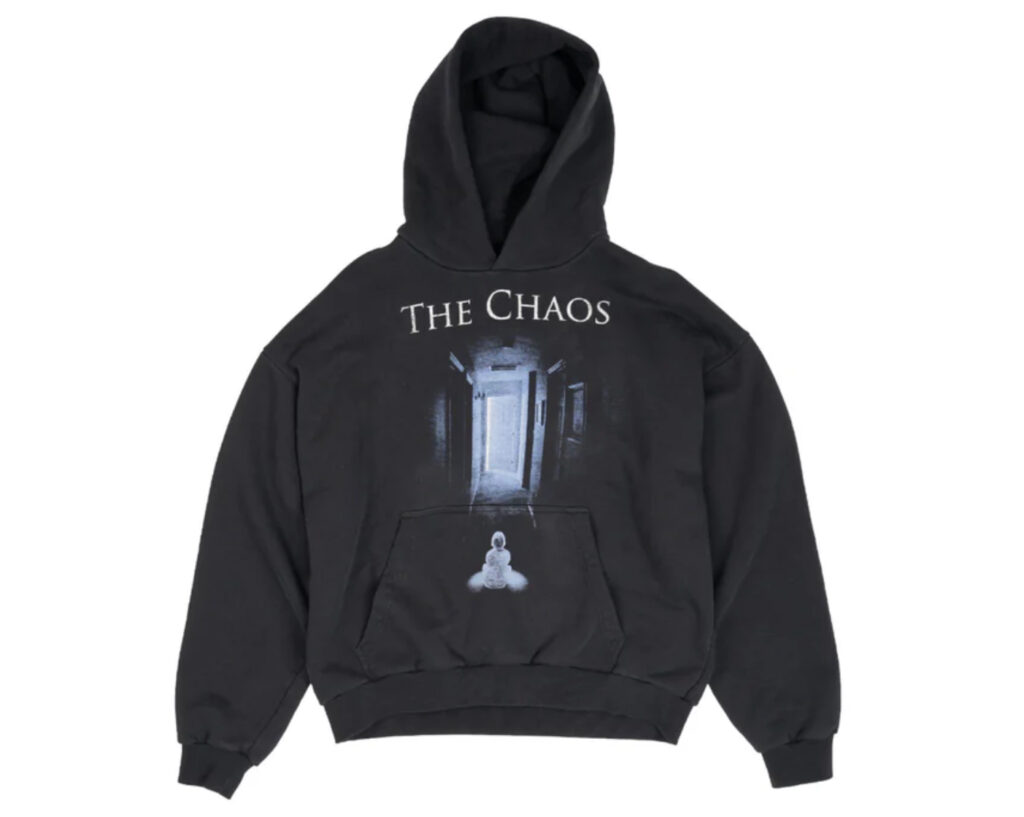
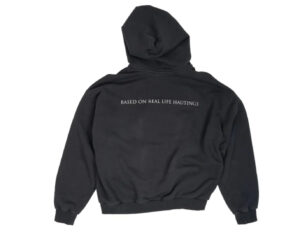
In the converging worlds of streetwear and subcultural aesthetics, few brands embrace the grotesque, the obscure, and the narratively chilling like Chaos Gone Global. The Polish label—known for its nihilistic overtones, lo-fi graphic language, and unapologetic allegiance to cinematic horror—emerges once again with a piece that is as sartorially aggressive as it is thematically dense: the Hautings Hoodie, part of the enigmatic “Horror Pack.”
Constructed from 450gsm heavyweight fabric fleece, the hoodie is more than a garment—it’s a wearable shrine to unease. With its jet-black canvas, surreal horror graphics, and confrontational text—“BASED ON REAL LIFE HAUTINGS”—the hoodie delivers a message that oscillates between irony and sincere folklore.
The Brand Behind the Madness: Chaos Gone Global
Before decoding the hoodie itself, one must first understand the psychological ecosystem of Chaos Gone Global. Founded in Poland during a surge of DIY nihilist fashion, the brand rapidly gained traction among youth disenchanted with sanitized global streetwear. Their DNA is steeped in Eastern European melancholy, horror cinema (particularly Giallo and post-Soviet thrillers), and a desire to disturb norms rather than complement them.
Chaos Gone Global frequently explores themes of urban folklore, esoteric symbolism, and emotional distortion, often borrowing visuals from VHS horror, surreal body modification art, and anonymous online ghost stories. The “Horror Pack” reflects their most committed thematic plunge to date—merging fashion with hauntology, a theory describing the persistent return of cultural ghosts.
Material and Construction: A Fortress of Fear
The Hautings Hoodie is cut from 450gsm cloth fleece, a weight category typically reserved for outerwear-grade streetwear. This is no delicate pullover—it is architectural in structure, thick enough to hold its silhouette even when draped on a hanger. The dense weave adds a feeling of psychological weight, reinforcing the brand’s metaphysical darkness through tactile sensation.
The hoodie features:
- Double-stitched seams for long wear, suggesting it’s meant for more than seasonal hype.
- A kangaroo pocket integrated into the graphic, disrupting traditional visual alignment.
- A double-layered hood, lending gravity and drama to its backdrop-casting presence.
This is a hoodie that doesn’t collapse into softness. Instead, it confronts the wearer, sculpting the body in sharp contrast to mainstream loungewear.
Visual Language: Horror as Graphic Identity
The most arresting feature of the Hautings Hoodie is its horror-film inspired artwork printed on the chest and across the front pocket. Rendered in muted whites and greys on black, the graphic adopts the visual dialect of grindhouse VHS covers, referencing films where fear was grainy, budgetless, and deeply psychological.
Details include:
- A central humanoid figure, seemingly mid-scream or transformation, rendered in low-resolution rasterized print—intentionally imperfect, suggestive of something decaying or unstable.
- A type treatment that mimics 1980s slasher typography, with scratched edges, uneven kerning, and subtle blood-drip motifs embedded into the contours.
- Misaligned symmetry, a trait used throughout the “Horror Pack” to unsettle the viewer and interrupt expectations of aesthetic cohesion.
The print is not merely decorative. It functions as a portal—visually referencing fear without ever explicitly stating a narrative. It invites the viewer to participate in the act of haunting rather than passively observe.
The Back Text: “Based on Real Life Hautings”
The pièce de résistance is the back text in all-caps block font:
“BASED ON REAL LIFE HAUTINGS.”
The deliberate typo—“HAUTINGS” instead of “hauntings”—is more than a printing quirk. It’s part of the brand’s post-linguistic play, suggesting something deeper:
- The word “haut” evokes French high-fashion (haute couture) while also implying “height” or elevation.
- Combined with “ings,” the typo reads like a ghostly elevation—a “hauting” being not a spectral visit, but a full possession.
It’s a subtle critique of horror’s commodification. By refusing to correct the spelling, the brand alienates the grammatically inclined viewer, nudging them into discomfort—a tactic used often in horror filmmaking to destabilize a sense of control.
Culture: Streetwear Meets Hauntology
The Hautings Hoodie doesn’t exist in a vacuum. It speaks to a larger trend of haunted fashion, where brands use horror not for gimmick, but as culture exorcism. Similar movements can be seen in:
- Cav Empt’s digital apocalypses
- Undercover’s bloody references to Suspiria
- Post-Internet brands like SANG BLEU, exploring tattoos, decay, and artificial immortality
What separates Chaos Gone Global is its commitment to the uncanny, blending the nostalgia of lo-fi media with the present-day dread of disconnection, climate instability, and moral ambiguity.
The “Horror Pack” isn’t camp. It’s not cosplay. It’s an attempt to dress the feeling of contemporary psychic unrest. The Hautings Hoodie, in particular, feels like the uniform of the emotionally exiled—a generation trying to cope with the real horrors that no scream queen can outrun: surveillance, silence, spiritual fatigue.
The Hoodie as Artefact: Collectibility and Cult Appeal
Garments like this don’t simply drop—they haunt collections. With limited runs, high-quality fabrication, and deep thematic ties, the Hautings Hoodie will likely:
- Become a collector’s grail among horror/streetwear archivists
- Be referenced in future retrospectives about subversive fashion during the 2020s
- Serve as a time capsule of post-pandemic dread and youth alienation
It aligns with the way we now view early Raf Simons or vintage Rick Owens—clothing that told a story before the mainstream knew how to listen.
Impression
The Chaos Gone Global Hautings Hoodie is more than a hoodie—it’s a declaration of aesthetic insurgence. In a streetwear world cluttered with ironic logos and influencer-led drops, this piece offers something deeply rare: an atmosphere.
From its heavyweight build to its spectral graphic language and conceptual spelling glitch, the hoodie isn’t trying to be liked. It’s trying to haunt you. And in doing so, it revives what fashion—at its most potent—has always done best: challenge, provoke, and narrate the invisible.
No comments yet.





